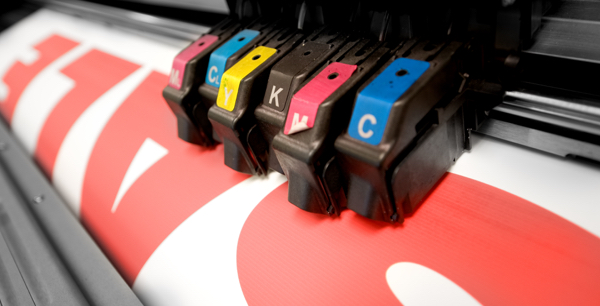10 Signs That It’s Time to Outsource
The Current State of Print Procurement
The demands on marketers are changing faster than ever before. Between multichannel engagement, rapidly shifting customer demands, and the need for personalized customer experiences, even the best CMOs are finding that their traditional goals of keeping costs low, ROI high, and campaign deliverables on-time are becoming more difficult and complex each quarter.
And one of the areas where marketing and organizational inefficiencies can have the biggest negative impact on your bottom line is the field of print procurement.
From retail signage to promotional collateral, to displays, to direct mailers, print marketing is the primary way customers physically interact with your brand.
So how can organizations know if their print marketing procurement is being weighed down with inefficiencies? There are several common warning signs.
Potential Symptoms of Inefficiency
We’ve identified ten (10) frequent symptoms of print procurement inefficiency in marketing department.
1. Rising Costs of Procurement and Distribution
“Cost creep” in the procurement and distribution of your print marketing materials can often be a sign of inefficiency, especially as your operations scale.
Efficient print procurement should keep costs constant – or even lower per item with volume buying agreements. Additionally, the procurement of printed materials is likely only a portion of the total cost to deliver these items. Without taking a full view of the creative, procurement, fulfillment and distribution process, you may not be addressing the true cost of the materials.
If your team is finding costs creeping upwards as you try to innovate or expand, the likely culprit is an inefficiency somewhere in your marketing supply chain.
2. Missed Deadlines, Leading to Rush Fees and Lost Opportunities
Your print marketing materials must be delivered on-time, every time.
If you find your printed materials are frequently missing deadlines or you’re being charged special rush fees to meet those deadlines, there is probably an efficiency bottleneck somewhere in your process, and you’re likely losing out on opportunities due to those delays.
An efficient print procurement process should not require rush fees to meet deadlines. It should be designed to give you MORE time to be reactive to the needs of the business and the marketplace.
3. Declining Material Quality
As we mentioned above, your print materials say a lot about your brand. Many times, they are the first impression you make with customers. You want print materials that are just as polished as your brand.
But if your organization is finding the quality of those materials declining (color consistency, finishing quality, handling concerns, etc.), or if you have to pay more just to get the same quality you originally had, blame may lie with a process inefficiency that is cutting into profit margins and leaving your team with a less-than-ideal output.
4. Lack of Buying Insight Leading to Waste
Knowledge is power. And when it comes to print procurement, a lack of knowledge can have serious consequences.
Many marketing organizations simply lack the insight and visibility into what is or is not being used. Waste can be accumulated in warehouses, closets, in retail locations, or salespeople’s trunks. Without an understanding of the true demand of the organization, you’re simply left to guess what the needs of the business truly are.
If you suspect you’re wasting money, but you can’t identify where, you may have an inefficient process on your hands.
5. Rogue Spending by Other Departments
Very much related to the above step, a lack of visibility can lead to “rogue spending.” Rogue spending occurs when employees in other departments make purchases they believe they need without going through the proper channels for approval.
This happens for two main reasons. First, a lack of visibility and communication of the correct process can lead employees to find their own sources of supply, with no consideration to leveraging a collective purchase.
But the other, more severe issue is one of time management. If your approval process is so full of bottlenecks, and delays that significant latency can creep in between demand and delivery, frustrated –and, frankly, self-motivated – employees may simply take it upon themselves to just “get it done.”
Of course, this leads to cost waste and can cause budget run-over if more purchases have been made. This results not only in inefficiency but, can lead to a broader corporate culture of frustration, distrust, resentment, and rivalry.

6. Inconsistent Output Due to Lack of Defined Standards
A lack of defined standards is usually a failing of a process, and ultimately, the result of inefficiency.
If your team is struggling with brand consistency – whether your print materials are arriving with the wrong Pantone colors, substrates, sizes, etc. – you’re sending the wrong impression to your customers.
Efficient print procurement should deliver the same product parameters, efficiently, across all orders and channels. If your print procurement process cannot, you likely have inefficiencies
hidden within.
7. Limited Feedback Loop with End Users
A big part of any efficient process is feedback. After all, you cannot improve unless you know what’s working and what isn’t.
If your print procurement process does not feature a built-in method for soliciting, evaluating, and implementing feedback from the end users of the print marketing materials in your organization, your process is not as efficient as it can and should be.
8. Inability to Shift to Different Options Due to Vendor Limitations
Similarly, efficient print procurement processes should offer the
option to pivot to different vendors based on your shifting needs.
For example, if you need print materials for an event or store location on the west coast, your team should be able to quickly and easily pivot to a vendor in California or Oregon to trim costs and delivery timelines.
If you cannot, because your process keeps you locked into a small handful of approved vendors, you are already dealing with the symptoms of process inefficiency.
9. Ill-Defined Process and/or Lack of Supporting Technology
One of the most important ways to boost process efficiency is to codify it. That is, best practices and proven optimizations should be written into your organizational processes so that they can be replicated and executed every time.
If you lack this – or, indeed, if you lack the technology stack required to execute these best practices and optimizations – chances are extremely high that inefficiencies are already cutting into your profit margins and delivery timelines.
10. Misaligned Incentives Between Procurement and Marketing
Ultimately, marketing and procurement should be working towards the same goals: improving revenues, lowering costs, winning more customers, etc.
But too often in large companies, these departments have become siloed from one another, and their goals have become misaligned.
If procurement’s only goal is to keep costs below a certain number while delivering a set volume of print materials per quarter, they will do whatever it takes to hit those numbers. This can lead to settling for lower quality print materials and inconsistent brand experiences if it means keeping costs low and velocity high.
Of course, that completely ignores – and indeed, sacrifices – several key marketing objectives, including brand consistency, brand perception, and brand loyalty.
Marketing and procurement need to work together, in unison, to achieve their shared goals. If they do not, or can not, you should examine your procurement process for inefficiencies.

Underlying Causes of Print Procurement Inefficiencies
While the symptoms of print procurement process inefficiencies are numerous and varied, there are two primary underlying causes of these symptoms.
Lack of a Marketing Supply Chain (MSC) Mindset
Your marketing operations are supply chain. You need to be managing it like one.
That means that you should optimize this process that brings your brand touch points to life, always keeping in mind critical KPIs like speed-to-market, cost efficiency, and brand consistency.
Whether it’s printed collateral, store signage, displays, direct mail, or promotional items, every step of the supply chain, from creation to procurement, to fulfillment, to distribution, should be considered as part of a unified, connected ecosystem and managed like one.
Lack of Knowledge/Resources to Effectively Manage
We understand that marketing teams are already stretched thin, tasked with doing more, with less, than ever before.
Many organizations simply lack the bandwidth to address their print procurement process with the scrutiny it needs. Whether your team lacks the time, budget, or procedural insight to manage it with the care it requires, lack of experience, knowledge, and resources can lead many teams to simply throw their hands in the air and say, “Oh, well.”
Outsourced Print Management Companies
Of course, there’s an alternative to these inefficiencies, misalignments, and lack of resources. It’s outsourced print management.
But “outsourced print management” doesn’t mean quite what many companies think it does.
Let’s take a look at three ways companies can leverage print management outsourcing.
Fully In-House Print Procurement
Currently, many companies have their print procurement and management operations completely in-house.
From creation to fulfillment to distribution, the success – or failure – of your print procurement rests solely on the shoulders of your own internal team.
This gives your brand the greatest possible amount of in-house oversight, but at a serious cost: you get none of the benefits of business process outsourcing (BPO) that have made it such an attractive and efficient solution in so many fields.
Sink or swim, your own company must have the bandwidth and resources to handle every aspect of the print procurement process.
Fully Outsourced Print Procurement
At the opposite end of the spectrum, you have fully outsourced print procurement.
In this model, your company reaps all the resource and bandwidth benefits of partnering with a trusted print procurement expert.
Your marketing team can focus on its job while you leave the procurement to someone else.
But this carries some problems that give many brands pause. The primary issue is the complete lack of control and oversight your team gives up. In a fully-outsourced model, many companies feel they aren’t able to exercise the level of review, oversight, and input they are comfortable with, and many feel their brand’s overall voice and execution are removed too far from their control.
A Balanced Approach to Print Management Outsourcing
But today, more and more brands are discovering a third, better way. And that way is print management outsourcing.
With print management outsourcing, you get the best of both worlds in a sort of hybrid between in-house and outsourced print procurement. Your marketing and procurement teams maintain control, review, input, and oversight over the process, outsourcing only the management of the procurement to a trusted partner.
As a result, your teams’ resources and bandwidth are augmented by the expertise and capabilities of the partner, leveraging purchase agreements, vast and flexible vendor networks, and proven best practices to provide cost savings, faster time-to-market, and dramatically improved efficiency.
*****
As marketing and procurement teams work harder and harder to keep up with changing customer demands, ever-thinner budgets, and more compressed timelines, smart ways to eliminate inefficiencies have become more important than ever.
By understanding the symptoms of process inefficiencies, their underlying causes, and the benefits of a hybrid-style print management outsourcing solution, companies can leverage the resource augmentation capabilities of print outsourcing while maintaining the critical brand control of in-house procurement.
Working with a trusted print management outsourcing partner can deliver the savings and flexibility that will help set your brand apart – all without settling for anything less than the very best print marketing materials your customers have come to expect from you.
Why NVISION?
For more than three decades we’ve partnered with Fortune 500 companies to deliver marketing operations solutions. Led by a strategic account management team, we’ll help you develop, procure, fulfill and distribute printed collateral, signage, point-of-purchase displays, direct mail, branded merchandise and much more.

 Project Title
Project Title Project Title
Project Title